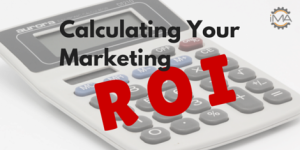Do you know how to measure the value of your marketing efforts?
 HubSpot’s State of Inbound 2015, the annual report compiled with info gathered from marketers and sales people around the world, was released recently. Needless to say there were quite a few points of interest.
HubSpot’s State of Inbound 2015, the annual report compiled with info gathered from marketers and sales people around the world, was released recently. Needless to say there were quite a few points of interest.
None more interesting, we think, than the single biggest challenge facing marketers today: No matter the size, or location of a business, or whether it was a B2B or B2C company, a majority of respondents said the biggest challenge they’re facing in 2015 is proving the return on investment of their marketing activities.
If you didn’t read our breakdown of the report, you might be surprised to learn that proving ROI was a bigger challenge than activities like securing more budget, or managing the business’s website. Only nonprofits put proving ROI at second place.
And that really is huge. If we’re not showing how the value we’re providing to our customers equals a monetary value for ourselves and our bottom line, then how do we know it’s working at all?
Or, more importantly, how do we know the time, effort, and resources we’re putting in, is worth it, or if we’re doing something right?
Where to Begin
First things first. Are you tracking and measuring your marketing activities to begin with? It’s very difficult (read: impossible) to know the difference you’re making if you aren’t keeping any measurable data points for your marketing activities. This starts with time spent on strategy, planning, research, and creation. How long does it take you to make one blog post? How long does it take you to create a landing page, or write copy for social media? Everything takes time, but you should also be measuring how that time translates into money or overall investment.
How do you calculate the amount of money it takes to create your marketing collateral? You can start with manpower.
- Are the content creators paid annual salaries, by the hour, or by the amount of words they write?
- For those full-time salaried employees, what are the overhead costs for them in addition to their pay?
- As in social security, healthcare, retirement fund investments?
- Does this person sit in your office (if you have one)? If so, a portion of rent should be attributed to the cost of content.
- Or do they work from home?
You may want to get down to the nitty gritty details of what your company spends its money on in order to obtain the most accurate amount of total investment for a piece of content.
Next you’ll need to calculate the value you place on goals or conversions, and what achieving those conversions is worth. If you sell an actual product, calculating the end profit can be quite easy, but if what you’re looking to gain from marketing activities is less cut and dry, there are a few aspects you can think about.
For example:
- What is a lead worth to you?
- What is a new customer worth to your company?
- What does a social share, or a follower earn you?
Of course not all of these things may have a true dollar amount to them, which is probably why calculating ROI is a tricky thing, but try to be as realistic and accurate as possible when assigning value to these conversion goals. You might also want to think about what the ‘lifetime’ value of a customer is, rather than what a one-off activity might get you.
How to Determine Lifetime Value
Imagine that you tweet a link to a blog post on your website, and that blog post has a call-to-action button on it that leads visitors to a landing page. On that landing page is a form for them to give you their information to receive emails from you.
Your conversion goals could be a few different things, starting small:
- a click on the link on your tweet,
- views of the blog post and potentially navigation to other blog posts,
- or pages on your website.
A click on the CTA which leads to a navigation to the landing page, and most importantly, a submission of a form with contact information, creating the ability to follow up on a lead, or try email marketing campaigns. Now when you do follow up on this lead, if it results in a purchase or subscription, then probably your ultimate goal has been fulfilled. Not every path to purchase is so direct, but you can think about each stage and the value it gives to your business and bottom line.
It’s unlikely that one stage of the purchasing journey can get all the credit for making the sale to a new customer, but knowing exactly what drove a customer to convert can be hard to figure out. Because of this, there are a few different attribution methods that most marketers subscribe to.
The ‘last touch’ attribution model gives all the credit to the last point of contact a customer had before making a purchase or fulfilling the goal. If more often than not, there are several steps a customer makes in their buying journey, you may want to consider a ‘multi-touch attribution’ which allots revenue to all parts incorporated in each step that a customer took on their path to purchase, either giving equal credit, or spread out into percentages based on the weight of that actual activity.
Speaking generally, if your typical sales process has four steps like the one discussed above (social media with link, blog post with call to action, landing page with form, lead follow up), then you can attribute full credit to the activity of following up on the lead, attribute an equal percentage of worth to each activity, or weigh each step differently based on perceived importance in the buyer’s journey.
Once an attribution type has been chosen that best fits your model for the purchasing process, and you’ve calculated the price for your marketing activity, then you can now calculate the ROI.
Let’s Calculate Your ROI
We can use a hypothetical situation, in which you are creating marketing campaigns for your software as a service company. Let’s say you have a blog post written by a contracted writer. That writer is paid hourly, and has no overhead costs associated with them. We can say, $35/ hour. It takes them 2.5 hours to write a blog post, so the total cost of the blog post is $87.50.
Now let’s say you are utilizing the blog post to drive customers to subscribe to your newsletter, with the hopes that you can then follow up and motivate them to sign up for your SaaS.
Say your SaaS costs $19 a month for small businesses, and someone has just signed up for a year’s worth of service. You may choose a weighted multi-touch attribution method that gives 30% of the credit to that blog post for securing that client.
In this case the annual revenue from this new customer is $228. If 30% can be attributed to the blog post, that means $68.40 of that total sale is from the blog.
Now take the revenue that can be attributed to the blog, and divide it by the cost to produce the blog. $68.40/87.50 = 78.17%.
Now, what you really want is for your calculated ROI to be over 100%. That means you’re not in the red, and you’re making more money from that content than you’re spending on it.
But one thing to remember is that this blog post may contribute to more than one new customer purchase, and that content marketing is a long game. Luckily for us, blog posts aren’t ‘one time use only’ pieces, and they can help your returns over time, as do most marketing activities. The important thing is to be tracking it.
As you can see here, it can be easy for us to think a particular piece or type of content is killing it in the revenue creating game, but it might not always be the case. Tracking your ROI will not just help you to see the returns you’re getting from content creation, but it will also make sure you’re identifying the real winners and losers in your stables to help you make more meaningful and valuable marketing activities in the future.
Proving ROI is certainly a challenge facing marketers today, but if you know how to calculate and track your ROI, you’ll be on your way to showing how your marketing activities are contributing to the bottom line.
